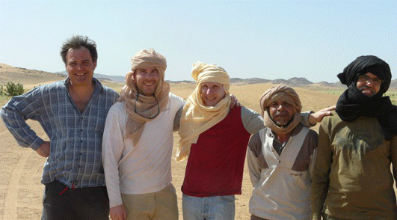On the flat, hard desert floor crescent-shaped barchan dunes form wherever winds originate from a predominant direction. Such mobile dunes advance relentlessly, a few centimeters a day, eventually covering roads or infrastructure that lie in the way. Our objective is to devise ways to keep this motion in check by enhancing sand cohesion.
A natural way to do so is to exploit moisture that forms small bonds at sand grain contacts, producing the cohesion that permits the building of sand castles. Moisture naturally permeates dunes after rain or as dew forms on their colder surface at dawn.
 In two recent field campaigns with an international team of scientists from France, the USA, Qatar and Mauritania, we recorded time-histories of temperature and humidity profiles just below the surface of desert barchans. Timelapse animations of these profiles can be found at http://grainflowresearch.mae.cornell.edu/geophysics/dunes/dunes.html
In two recent field campaigns with an international team of scientists from France, the USA, Qatar and Mauritania, we recorded time-histories of temperature and humidity profiles just below the surface of desert barchans. Timelapse animations of these profiles can be found at http://grainflowresearch.mae.cornell.edu/geophysics/dunes/dunes.html
A crucial input to understanding temperature variations was to record simultaneously the net-radiation flux to and from the dune surface, regardless of wavelength. This is why we turned to the Kipp & Zonen NR Lite2, which constitutes a relatively inexpensive instrument for broad-band net radiation measurements.
The NR Lite2 output signal was amplified by a factor of 100 using a battery-powered custom amplifier to accommodate the input range of a National Instruments CompactRIO data acquisition system. This allowed us to operate autonomously for up to 60 hours at a stretch on Lithium-Polymer batteries. Simultaneously, we recorded signals from a temperature probe and a unique capacitance instrument that we created to measure depth profiles of extremely low humidity levels.
Our modeling of sand heat transfer near the surface confirmed that the principal contribution to the heat flux at the dune surface is radiative. With its well-documented sensitivity, the NR Lite2 allowed us to model the temperature profile accurately without further calibration.
This work is sponsored by the Qatar National Research Foundation. Participants include Anthony Hay, Alexandre Valance, Ahmed Ould el-Moctar, Renee Richer, Christopher Ogden, Patrick Chasle, and Sara Abdul-Majid.